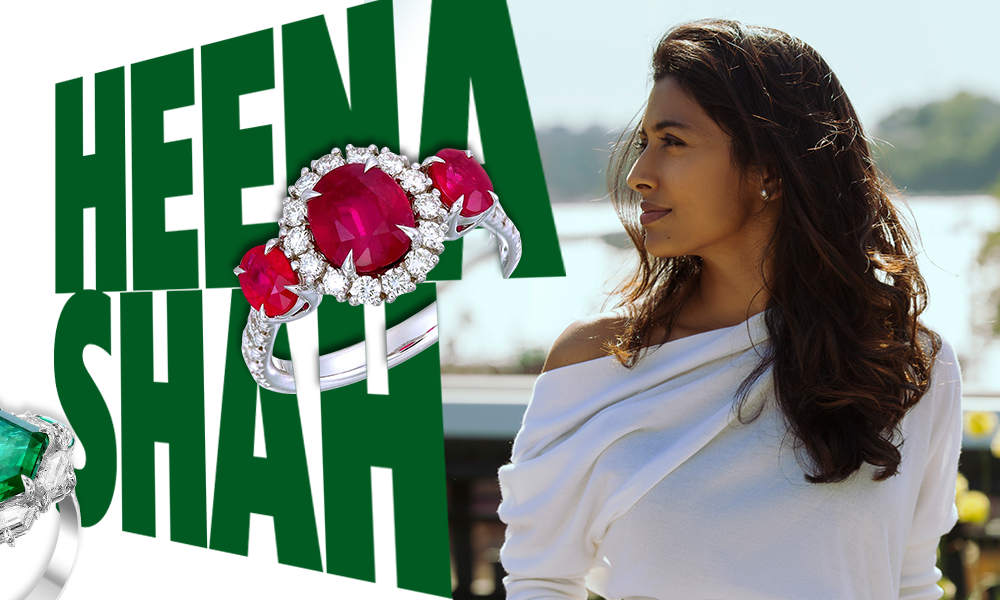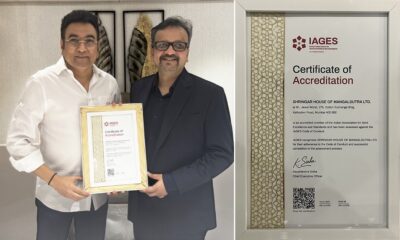JB Insights
Future of AI in jewellery industry lies in customized, value-driven solutions

Aniruddha Pal, Co-Founder and CEO, Algoneering speaks to JewelBuzz on the present and future of AI in the jewellery industry . He underscores that success of AI hinges on collaboration, data sharing, and a deep understanding of the specific needs of each organization. By embracing these principles, the industry can unlock the full potential of AI to enhance creativity, streamline operations, and ultimately drive greater success.



AI’s Role in the Jewellery Industry
AI is revolutionizing the jewellery industry across disciplines such as designing, manufacturing, streamlining operations, and even ERP and customer solutions. Its presence is reshaping the way operations are conducted, offering new efficiencies and possibilities.
AI Integration Across Industries
AI is making its mark in every industry, from fashion to daily life operations. The jewellery industry, being layered and complex, presents unique challenges. As tech entrepreneurs, we started exploring its potential three years ago, even without a deep jewellery background.
Early Challenges in AI for Jewellery
Initially, the idea of AI designing jewellery seemed far-fetched. Today, the focus has shifted to refining and improving AI-generated designs. The industry is ideating and exploring solutions to its daily challenges, though AI adoption requires clarity on specific problem statements.
AI’s Efficiency Over Perfection
While AI may not yet meet 100% accuracy, its ability to perform even 20% of tasks with high efficiency is valuable. For instance, tools like generative AI simplify processes like content creation, saving significant time on repetitive tasks.
Customization as a Core Requirement
Every organization in the jewellery industry has unique needs and perspectives. One-size-fits-all solutions don’t work. Customization, value-driven approaches, and understanding industry-specific nuances are essential for successful AI integration.
Operational Challenges in Jewellery Manufacturing
Jewellery manufacturing involves significant manual effort, leading to potential errors and missed deadlines. Streamlining operations with AI and implementing strong SOPs can address these issues effectively.



Generative AI in Jewellery Design
Generative AI offers inspiration by creating original jewellery concepts. However, the jewellery industry requires tailored platforms that focus on creating industry-specific designs rather than relying solely on generic tools.
Building a Strong AI Ecosystem
Establishing a robust AI system requires resource allocation, team upskilling, and infrastructure development. Solely relying on AI without supporting resources is not sustainable for long-term growth.



Industry Excitement vs. Realistic Adoption
While there is significant excitement about AI in the jewellery industry, the pace of adoption is slower than expected. Awareness, resource constraints, and organizational protocols are key factors impacting progress.
Importance of Data and Democratization
For AI to thrive, the industry must focus on structured data collection and sharing while maintaining security protocols. The example of Tata Memorial Hospital democratizing MRI data highlights the potential benefits of such an approach.



AI Penetration and Resource Constraints
Penetration of AI in the jewellery sector is slow due to limited awareness and specialized resources. While large brands may have dedicated AI teams, smaller manufacturers face cost and expertise challenges.
Customization and Collaboration as the Future
The future of AI in jewellery lies in customized, value-driven solutions. It hinges on collaboration, data sharing, and a deep understanding of the specific needs of each organization. Collaborative efforts between organizations and AI developers are crucial to training machines with relevant data and building effective models.
AI’s Role in Workflow and SOPs
While AI fits well in product development and reducing design timelines, a strong SOP framework is essential to complement its capabilities. This ensures precision and efficiency in the manufacturing process.
Overcoming Initial Resistance
Early resistance to AI stemmed from data-sharing insecurities and doubts about its ability to understand jewellery-specific nuances. Gradual adoption and collaboration have improved trust and usability.
The Journey Towards Realistic AI Designs
Significant progress has been made in training AI to design realistic jewellery pieces by addressing challenges like material composition, design elements, and client customization needs.



A Vision for the Future
Customization will continue to be the key driver of AI adoption. Structured data, team skill development, and a strong AI vertical are essential for achieving efficiency and long-term success in the jewellery industry.

Collaboration for a Better Future
To unlock AI’s full potential, industry bodies and councils must support collaborative efforts. This collective approach will help create successful models and drive the jewellery industry towards a promising future.
Designer Focus
Valani Atelier:Inspired by the quiet order of nature, symmetry of architecture and the emotional resonance of human stories.
Heena Shah, Valani Atelier underscores how her design is at the intersection of art, engineering, and emotion.

Speaking to JewelBuzz she passionately explains that she is inspired by the quiet order of nature, the symmetry of architecture, and the emotional resonance of human stories.She talks of her design philosophy, creative process, commercial viability and more
How would you describe the core design philosophy of Valani Atelier?Â
At Valani Atelier, we design at the intersection of art, engineering, and emotion. Guided by the Golden Ratio, each piece is a study in s, ymmetry and proportion—where precision meets poetry. My background in industrial engineering shapes our creative process, ensuring every curve and contour achieves both structural integrity and aesthetic harmony. Inspired by nature’s geometry and modern architecture, our jewelry balances innovation with timelessness. We believe true luxury lies in creating beauty that endures—pieces that resonate not just in the moment, but for generations to come.
What inspires your creations — art, architecture, nature, or personal emotion?Â
I’m inspired by the quiet order of nature, the symmetry of architecture, and the emotional resonance of human stories. Each Valani Atelier creation begins with a fascination for proportion and harmony—often guided by the Golden Ratio—to reveal beauty through balance. My engineering background shapes how I translate this structure into design, where mathematics meets emotion and precision becomes poetry.
Equally, I’m inspired by the artisans who bring these visions to life. Their craftsmanship fuels my commitment to social innovation—using design to preserve heritage skills, create equitable value chains, and prove that beauty and impact can coexist by design.
How do you balance traditional craftsmanship with contemporary aesthetics in your designs?Â
I strive to bridge the gap between heritage and innovation in my jewelry designs. Rooted in traditional craftsmanship, my work showcases meticulous stone setting, intricate detailing, and time-honored techniques that reflect the legacy of fine jewelry making. Each piece is crafted with precision, honoring the artisanal skills that define luxury. At the same time, I aim to infuse my creations with a bold, contemporary spirit. My designs feature striking gemstone arrangements, unexpected silhouettes, and organic forms that speak to modern sensibilities. Whether it’s a sculptural emerald ring or a floral-inspired ruby piece, I enjoy reimagining classic motifs through a fresh, artistic lens—creating jewelry that feels both timeless and current. My work is a celebration of duality: the elegance of tradition and the excitement of innovation, brought together in pieces that resonate with today’s confident, expressive wearer.
How has your design approach evolved since founding Valani Atelier?Â
Since founding Valani Atelier, my design approach has evolved from classic elegance to a more expressive and contemporary aesthetic. Early pieces focused on symmetry, traditional prong settings, and timeless gemstone combinations like emeralds and diamonds. Over time, I’ve embraced bolder silhouettes, asymmetrical compositions, and nature-inspired forms. Color has become more adventurous, and the interplay between structure and softness is more pronounced. While my commitment to craftsmanship remains unwavering, this evolution reflects a journey—from honoring tradition to redefining it—crafting jewelry that speaks to modern individuality while preserving the soul of timeless artistry.
Could you walk us through your creative process—from concept sketch to final piece?Â
Each jewelry piece I create begins as a spark of inspiration—sometimes it’s the gentle curve of a leaf, the interplay of light and shadow in a cityscape, or a fleeting emotion that lingers in my mind. I start by sketching these ideas by hand, letting the lines and shapes evolve naturally on paper. As I select gemstones, I place them directly onto my sketches, experimenting with color and balance until the composition feels just right. The process is tactile and intuitive, blending artistry with technical precision as I refine every detail to ensure the design is both beautiful and wearable. Once the vision is clear, I work with skilled artisans to bring the piece to life, translating my sketches into prototypes and carefully setting each stone by hand. The final step is always a moment of quiet satisfaction—polishing, inspecting, and perfecting the piece so it can be worn as a true expression of individuality and elegance.
What gemstones are you personally drawn to, and why? Do you have a favorite metal to work with?Â
I am deeply drawn to the expressive beauty of emeralds and rubies. These gemstones are not only rich in color and symbolism but also offer a timeless elegance that aligns with my design philosophy. Emeralds evoke a sense of renewal and sophistication, while rubies bring warmth and passion. My favorite metal to work with is white gold, chosen for its clean, luminous finish and ability to enhance the brilliance of colored gemstones. It provides a modern yet classic foundation, allowing my designs to feel both luxurious and wearable.
How do you ensure that each design retains a sense of individuality while maintaining the brand’s signature style?Â
For me, every design begins with a unique inspiration—sometimes it’s the character of a gemstone, a fleeting moment in nature, or a personal memory. I strive to let each piece have its own voice, while still reflecting the signature elegance and expressive forms that define Valani Atelier. By collaborating closely with artisans and refining every detail, I ensure that individuality shines through, yet each creation remains unmistakably part of my brand’s story.
Is there a particular piece or collection that you feel best embodies the essence of Valani Atelier?Â
The Andromeda collection. My fascination for celestial formations began while star gazing at night with my young son. Peering through a tiny lens, we witnessed how newly formed star clusters lay in the center of a nebulae. The Andromeda series attempts to capture a glimpse of the galaxy by aligning magnificent center gemstones to fancy cut trillions and brilliant rounds.
In a market increasingly driven by trends, how do you ensure commercial viability without compromising artistry?Â
I design with longevity in mind, favoring classic silhouettes and enduring materials like emeralds, rubies, and gold. Yet, I stay attuned to evolving tastes by incorporating subtle trend-forward elements, such as modern cuts, asymmetry, or unexpected color pairings. By offering limited-edition collections and custom design services, I preserve artistic freedom while meeting market demand. This model allows me to experiment creatively without overproducing or diluting my brand identity.
What challenges do independent jewelry designers face when scaling a brand globally?Â
Scaling a jewelry brand globally brings unique challenges, especially when it comes to adapting designs for different cultures. For example, when I introduced the Andromeda collection in Texas, I noticed that clients were drawn to pieces with bold, vibrant gemstones and larger, statement settings—reflecting the region’s love for expressive style and individuality. This experience taught me the importance of listening to local preferences and being flexible with my designs, while still staying true to the core identity of Valani Atelier. Balancing universal appeal with local relevance is an ongoing journey, but it’s also what makes global expansion so rewarding.
How do you see the role of storytelling and branding in attracting today’s luxury consumer?Â
Today’s luxury consumer, especially Gen Z, is drawn to authenticity, individuality, and sustainability. I embrace this shift by sharing the real journey behind each piece—from my sketches to the final creation. By highlighting my creative process, ethical sourcing, and artisan craftsmanship, I build trust and emotional connection with younger audiences. I meet them where they are—online—through visually rich storytelling, behind-the-scenes content, and interactive experiences that make the brand both aspirational and accessible.
Have you noticed a shift in what younger clients look for in fine jewellery compared to older generations?Â
Younger clients seek versatility, meaning, and design-forward pieces that reflect their identity, while older generations often prioritize heritage, investment value, and classic elegance. I strive to bridge these preferences by offering pieces that are artistically timeless yet emotionally current, appealing across generations while staying true to my brand’s DNA.
Closing remarks and message to young jewelry designersÂ
Your creativity is your compass. In a world full of trends and noise, stay rooted in your vision. Let your designs speak not just through beauty, but through the stories you tell, the materials you choose, and the values you uphold. Remember: every sketch is a seed, every gemstone a voice, and every finished piece a reflection of your soul. Keep designing with intention, and the world will listen.
-

 JB Insights21 hours ago
JB Insights21 hours agoTransforming the Future of Precious Metal Processing — Doit Industries’ New Line of Smart Systems
-

 BrandBuzz2 days ago
BrandBuzz2 days agoMCA raises “small company” thresholds – up to ₹10 cr capital & ₹100 cr turnover from 1st December 2025, major relief for jewellery trade
-

 National News21 hours ago
National News21 hours agoShringar House of Mangalsutra Secures IAGES Accreditation, reinforcing its leadership in ethical gold standards
-

 National News27 minutes ago
National News27 minutes agoSilver Hits Record High as Rupee Slumps









